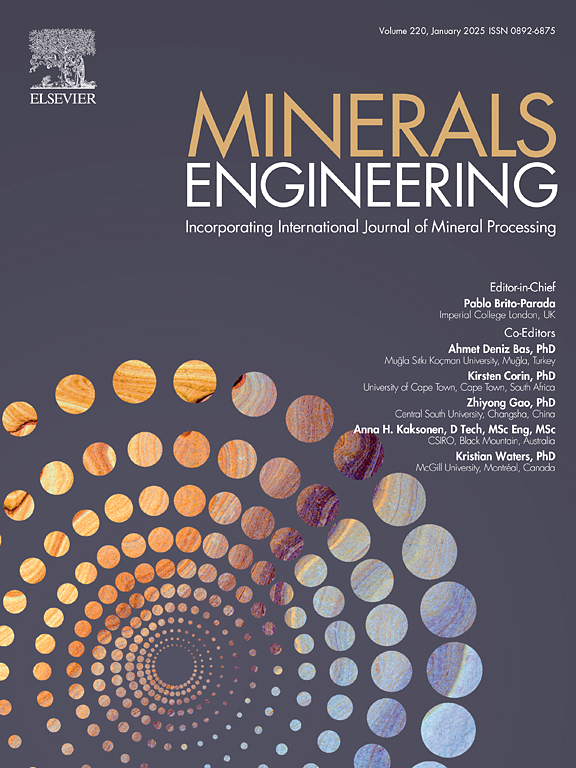基于工艺的技术经济模型的发展,用于评估沥青提取尾矿中关键矿物的回收
IF 5
2区 工程技术
Q1 ENGINEERING, CHEMICAL
引用次数: 0
摘要
锆石和钛等关键矿物对低碳经济的发展至关重要,可再生能源技术的进步推动了对这些矿物的需求不断增长。沥青提取尾矿,特别是从泡沫处理操作,代表这些矿物的未充分利用的来源。本文对从沥青泡沫处理尾矿中回收锆石和钛进行了技术经济评价。该过程有两个阶段:重矿物浓缩和分离。在第一阶段,尾矿经过脱泥、浮选和溶剂萃取,以浓缩重矿物。在第二阶段,精矿通过浮选、重力、静电和磁性技术分离成锆石、金红石、钛铁矿和亮晶石。开发了一个数据密集型流程模型,用于计算材料和能源平衡、设备尺寸、资本和运营成本以及内部回报率(IRR)。一家每年处理1550万吨尾矿的工厂可以回收15.7万吨重矿物,按当前锆石和金红石的市场价格计算,其内部收益率为9.8%。将该过程分为两个阶段,其内部收益率为7.6%,其中容量和锆石价格是影响最大的因素。敏感性分析表明,根据输入的不确定性,内部收益率可能在6.9%至11.5%之间。本研究为关注从沥青开采废料中回收关键矿物的经济潜力、支持循环经济和能源转型目标的利益相关者提供了有价值的见解。本文章由计算机程序翻译,如有差异,请以英文原文为准。

The development of process-based techno-economic models for the assessment of critical minerals recovery from bitumen extraction tailings
Critical minerals such as zircon and titanium are essential for the development of a low-carbon economy, with increasing demand driven by advancements in renewable energy technologies. Bitumen extraction tailings, specifically from froth treatment operations, represent an underused source of these minerals. This study presents a techno-economic assessment of recovering zircon and titanium from bitumen froth treatment tailings (FTT). The process has two stages: heavy mineral concentration and separation. In the first stage, tailings undergo desliming, flotation, and solvent extraction to concentrate heavy minerals. In the second stage, the concentrate is separated into zircon, rutile, ilmenite, and leucoxene using flotation, gravity, electrostatic, and magnetic techniques. A data-intensive process model was developed to calculate material and energy balances, equipment sizes, capital and operating costs, and internal rate of return (IRR). A plant processing 15.5 million tonnes of tailings annually can recover 157,000 tonnes of heavy minerals, generating an IRR of 9.8% at current market prices for zircon and rutile. Separating the process into two stages results in an IRR of 7.6%, with capacity and zircon price being the most influential factors. Sensitivity analysis shows that the IRR could range from 6.9% to 11.5% depending on input uncertainties. This study provides valuable insights for stakeholders interested in the economic potential of recovering critical minerals from bitumen extraction waste, supporting the circular economy and energy transition goals.
求助全文
通过发布文献求助,成功后即可免费获取论文全文。
去求助
来源期刊

Minerals Engineering
工程技术-工程:化工
CiteScore
8.70
自引率
18.80%
发文量
519
审稿时长
81 days
期刊介绍:
The purpose of the journal is to provide for the rapid publication of topical papers featuring the latest developments in the allied fields of mineral processing and extractive metallurgy. Its wide ranging coverage of research and practical (operating) topics includes physical separation methods, such as comminution, flotation concentration and dewatering, chemical methods such as bio-, hydro-, and electro-metallurgy, analytical techniques, process control, simulation and instrumentation, and mineralogical aspects of processing. Environmental issues, particularly those pertaining to sustainable development, will also be strongly covered.
 求助内容:
求助内容: 应助结果提醒方式:
应助结果提醒方式:


